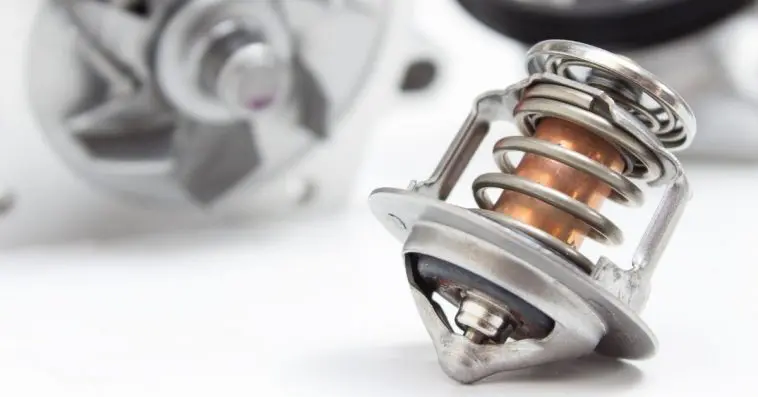A car engine has an optimum temperature (195 – 220 degrees Fahrenheit) at which it works really well. If that temperature is too high or too low, it is a sure sign that something’s not right.
It’s the thermostat’s job to regulate the temperature and keep it at optimum levels.
TABLE OF CONTENTS
Yes, But How Does A Thermostat Work In My Car?
The thermostat is a valve that responds to the temperature of the engine coolant. If the engine gets too hot, the thermostat valve will open to flush coolant into the radiator.
If it’s too cold, the thermostat valve will remain open and keep the coolant in the engine.
Are you still confused? Don’t be. I’ll give you all the lowdown in this guide.
I’ll tell you:
- What it is – how it all fits together
- How it does its job – it’s really clever science
- How to troubleshoot your thermostat – to get you out of a fix
- How to check if your car’s thermostat is working properly – couldn’t be simpler
A Car Thermostat? What Exactly Is It?
A car thermostat is really nothing more than a valve. It can open and it can close.
By opening and closing under certain conditions, it regulates the flow of engine coolant between the radiator and the engine.
It fits in the palm of your hand, but if it doesn’t work, the resulting high temperatures could lead to a cracked engine block or a blown head gasket.
So, it’s a small part, almost easy to miss, but take it out of the equation and the results can be catastrophic.
So, tiny in the bigger scheme of things, but HUGELY important for the health of your car’s engine.
How Does It Do That?
There are incredible energies at play in the running engine of a car. These energies translate into heat.
For the engine to run properly, that heat has to go something and the engine has to cool down.
When the engine coolant gushes through the car’s engine, it picks up the excess heat from the metal of the engine block. From there, the coolant flows back into the radiator.
Inside the radiator, cool air blows across the fins, and the water is cooled down. Now the coolant flows back into the engine to collect the excess heat again.
The thermostat controls the flow of that coolant between the engine and the radiator.
When the coolant is too hot, it opens and allows the coolant to flow from the engine to the radiator to cool down.
Once it is cooler, the thermostat stays closed and lets the coolant circulate through the engine to collect the excess heat again.
Wash, rinse, repeat.
What Causes The Car Thermostat To Open Or Close?
This is really a little piece of scientific genius. The thermostat has a specific kind of wax. This wax expands and contracts as the temperature fluctuates.
When things get too hot, the wax expands, and it pushes the thermostat opens.
Conversely, when the temperature cools down, the wax contracts and the valve closes.
How Do I Know My Car’s Thermostat Is Faulty?
I’ve spoken about excessive temperatures and the engine block damage and blown gaskets that can result. Here’s how it happens and what the signs are.
1. The Engine Simply Doesn’t Perform Anymore
When you’re in the desert without water, you have little chance of survival. I know, I know, the example is extreme, but it will serve well. Bear with me.
Water serves to cool the human body down. Without it, in such a hot climate, your body will overheat and you’ll die.
Just try running a mile or two when you’re dehydrated. You’ll be on your knees before you know it!
Your car works in much the same way. Without an effective thermostat, the engine has absolutely no hope of cooling itself down.
As soon as the heat becomes extreme, the engine will start performing badly and you’ll notice a severe loss of power as it fights to keep up with the car’s demands.
This will happen when the problem with the thermostat has already gone too far.
Initial signs will be something more subtle, like a steep drop in your gas mileage. Or severe fluctuations on the temperature gauge in your instrument panel.
2. Your Engine’s Temperature Readings Are All Wonky
If you drop your eyes to your car’s temperature gauge every now and again, you’ll be used to the normal temperature range in which your car functions by now.
If your thermostat is on the fritz, your temperature indicator will be out of the normal parameters – sometimes WAY out of range.
On the one side of the equation, the thermostat valve could be stuck in the open position. This means the coolant will flow all the time.
It makes the engine work harder because it won’t be able to reach optimal temperatures. Your gas mileage will take a dive.
On the other side, the thermostat valve could get stuck in the closed position. This could be a major problem. The car will run at excessively high temperatures, and this could do real damage.
A car’s engine can overheat for several reasons, but when it happens, check your thermostat first.
3. Your Car’s Temperature Is Up And Down Like A Yoyo
This really speaks for itself, doesn’t it? If the temperature continually increases and decreases for no apparent reason, the thermostat valve may have an issue.
4. Leaks, Leaks, Those Damned Leaks …
Do you have icky green puddles under your car? That could be a sign that your car’s thermostat isn’t working properly.
If it gets stuck and doesn’t allow the flow of coolant, the hoses can become frayed and porous. That’s where your leaks could be from.
Check your car’s thermostat.
So, How Do I Check If The Thermostat Is Faulty?
It’s really easy. To check if it is stuck in the open position:
- Start your car and let it idle for a few minutes.
- Remove the cap from the radiator, and check if there’s any coolant, and if it’s flowing.
- If you only let the car idle for a few minutes, the engine should still be pretty cool, so there should be no coolant flow. If there is flow, your thermostat may be stuck in the open position.
To check if the thermostat is stuck in the closed position:
- Start the engine and let it warm up to working temperature.
- Check the radiator (as above) to see if the coolant is flowing.
- If it’s not, the thermostat is most likely stuck in the closed position (this should match a rising temperature on your gauge.
If either one of the above occurs, get a new thermostat. If you have wrenches for fingers, doing it yourself will probably set you back around $100 or so.
If you take a trip down to your friendly neighborhood mechanic, you’ll get it done for around $200.
In Conclusion: A Small Part That Makes ALL The Difference
So, how does a car’s thermostat work? There’s your answer. It’s a small part that has a huge job.
If it works properly, your car’s temperature will always be optimal. You’ll get great mileage and the engine will purr like a kitten.
If it doesn’t work or doesn’t work well, you could be in for a world of hurt.
The key is ALWAYS to have something checked out if it’s not working. It could save you a bundle in the long run.




